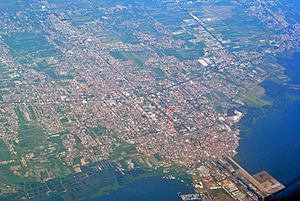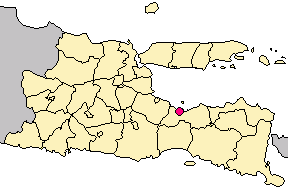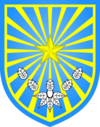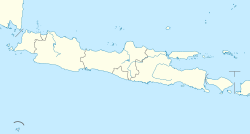Probolinggo facts for kids
Quick facts for kids
Probolinggo
|
||
|---|---|---|
|
City
|
||
| City of Probolinggo Kota Probolinggo |
||
| Regional transcription(s) | ||
| • Javanese | Prabâlingghâ (Gêdrig) ڤراباْليڠڬْاْ (Pégon) ꦥꦿꦧꦭꦶꦁꦒ (Hånåcåråkå) |
|

Aerial view of Probolinggo, 2015.
|
||
|
||
| Nickname(s):
Kota Anggur (City of Grapes)
|
||
| Motto(s):
Tri Karsa Bina Praja
(Developing the city by Three Means) |
||

Location within East Java
|
||
| Country | ||
| Region | Java | |
| Province | ||
| Settled | 4 September 1359 | |
| Gementee | 1 July 1918 | |
| Area | ||
| • Total | 56.676 km2 (21.883 sq mi) | |
| Elevation | 25 m (82 ft) | |
| Population
(mid 2023 estimate)
|
||
| • Total | 246,980 | |
| • Rank | 48 | |
| • Density | 4,357.75/km2 (11,286.5/sq mi) | |
| Time zone | UTC+7 (Indonesia Western Time) | |
| Postcode |
6xxxx
|
|
| Area code | (+62) 335 | |
| Vehicle registration | N | |
Probolinggo is a city located on the northern coast of East Java province in Indonesia. It covers an area of about 56.676 square kilometers. In mid-2023, the city had an estimated population of around 246,980 people.
Even though it used to be the capital of Probolinggo Regency, the city of Probolinggo is now a separate area. Like many places in northern East Java, Probolinggo is home to a mix of people, including many from the Madurese and Javanese ethnic groups.
The city is located on one of the main highways that crosses the island of Java. It also has a busy harbor, which is used a lot by fishing boats.
During the time when the Dutch East Indies ruled, especially in the 1800s, Probolinggo was an important center for making and selling sugar. Even today, sugar is still a key product from this region.
Probolinggo is also well-known for its delicious mangoes, which are locally called mangga manalagi. Special dry-season winds, known as angin gending, blow from July to September. These winds help the mango trees grow well and are thought to be why the area's fruit is so good. The city used to grow grapes too, but not many are grown there now.
The city's motto is "Bestari." This word is a short form of several Indonesian words: bersih (clean), sehat (healthy), tertib (orderly), aman (safe), rapi (neat), and indah (beautiful).
Contents
What's in a Name?
In an old text called Negarakertagama, Probolinggo was once called Banger. This Javanese word means bad odor.
However, in 1770, a leader named Regent Joyonagoro changed the city's name to Probolinggo. This new name comes from two words: praba, meaning 'light', and lingga, which can mean a 'symbol of masculinity'. Another idea is that the name comes from prabu (king) and linggih (stop by).
A Look at Probolinggo's Past
Colonial Times
In 1743, the Dutch East India Company took control of many parts of eastern Java, including Probolinggo. This happened after a conflict called Geger Pacinan.
Later, in 1811, during the time of Dutch Governor General Daendels, Probolinggo was sold to a Chinese man named Han Tik-Ko. He paid a large sum of money and was given important titles like "Mayor Cina" (Chinese mayor) and "Probolinggo Landlord." People in Probolinggo also called him "Babah Tumenggung."
However, the people of Probolinggo were unhappy with Han Tik-Ko because he made them pay very high taxes. This led to a conflict on May 18, 1813, known as the Kedopok War. During this event, Han Tik-Ko was killed. After this, the Dutch Lieutenant Governor Stamford Raffles bought the city back from Han Tik-Ko's family.
Early Independence and Revolution
After World War II, in 1946, Japanese soldiers who were prisoners of war were sent back home from Probolinggo port.
During the Indonesia National Revolution, Probolinggo faced challenges from Dutch ships. In 1947, Dutch ships were seen near the coast, searching and chasing away local boats.
To protect the city, the Probolinggo Regional Defense Council made the naval defenses stronger. Because of this, the Dutch forces later decided to enter the city by land instead of by sea.
City Districts
Probolinggo city is divided into five main areas called districts (kecamatan). Each district has its own center with the same name. These districts are further divided into urban villages called kelurahan.
| Kode Wilayah |
Name of District (kecamatan) |
Area in km2 |
Pop'n census 2010 |
Pop'n census 2020 |
Pop'n estimate mid 2023 |
No. of villages |
Post codes |
|---|---|---|---|---|---|---|---|
| 35.74.03 | Mayangan | 8.66 | 60,446 | 61,768 | 62,300 | 5 | 67216 - 67219 |
| 35.74.04 | Kanigaran | 10.65 | 54,604 | 60,230 | 61,990 | 6 | 67221 - 67225 |
| 35.74.01 | Kademangan | 12.75 | 39,920 | 44,623 | 46,090 | 6 | 67221 - 67226 |
| 35.74.05 | Kedopok | 13.62 | 30,404 | 37,815 | 40,320 | 6 | 67227 - 67239 |
| 35.74.02 | Wonoasih | 10.98 | 31,688 | 35,213 | 36,290 | 6 | 67232 - 67239 |
| Totals | 56.67 | 217,062 | 239,649 | 246,980 | 29 |
Getting Around Probolinggo
Probolinggo used to have a tram system that ran across the city, built in 1894.
The city is a central point for travel, with major roads connecting it to other important cities in East Java. You can travel west to Surabaya, south to Jember, and east to Banyuwangi.
Bus Travel
The Bayuangga bus station serves both the city and the surrounding area. From here, you can catch buses to Surabaya, Malang, and Jember.
Train Travel
The Probolinggo railway station connects the city to most major cities on Java. However, if you want to go to the capital city, Jakarta, you'll need to change trains in either Surabaya or Yogyakarta.
Air Travel
Probolinggo does not have its own airport. The closest major airport is the Juanda International Airport in Surabaya. Thanks to a new toll road, it's less than a 2-hour drive away.
Probolinggo's Weather
Probolinggo has a tropical savanna climate. This means it has a wet season with heavy rainfall from December to March. The rest of the year, from April to November, sees moderate to little rain.
| Climate data for Probolinggo | |||||||||||||
|---|---|---|---|---|---|---|---|---|---|---|---|---|---|
| Month | Jan | Feb | Mar | Apr | May | Jun | Jul | Aug | Sep | Oct | Nov | Dec | Year |
| Mean daily maximum °C (°F) | 32.2 (90.0) |
32.0 (89.6) |
32.0 (89.6) |
32.0 (89.6) |
31.8 (89.2) |
31.8 (89.2) |
31.7 (89.1) |
32.3 (90.1) |
33.1 (91.6) |
33.6 (92.5) |
33.4 (92.1) |
32.5 (90.5) |
32.4 (90.3) |
| Daily mean °C (°F) | 27.2 (81.0) |
27.1 (80.8) |
27.0 (80.6) |
26.8 (80.2) |
26.3 (79.3) |
25.7 (78.3) |
25.1 (77.2) |
25.6 (78.1) |
26.4 (79.5) |
27.1 (80.8) |
27.6 (81.7) |
27.2 (81.0) |
26.6 (79.9) |
| Mean daily minimum °C (°F) | 22.2 (72.0) |
22.2 (72.0) |
22.0 (71.6) |
21.7 (71.1) |
20.9 (69.6) |
19.7 (67.5) |
18.6 (65.5) |
19.0 (66.2) |
19.7 (67.5) |
20.7 (69.3) |
21.8 (71.2) |
21.9 (71.4) |
20.9 (69.6) |
| Average rainfall mm (inches) | 242 (9.5) |
240 (9.4) |
198 (7.8) |
109 (4.3) |
80 (3.1) |
45 (1.8) |
19 (0.7) |
7 (0.3) |
7 (0.3) |
18 (0.7) |
75 (3.0) |
168 (6.6) |
1,208 (47.5) |
| Source: Climate-Data.org | |||||||||||||
Who Lives in Probolinggo?
In 1845, a count showed that there were many Javanese and even more Madurese people living in Probolinggo.
By 1930, a more detailed count showed that most people in Probolinggo were local Indonesians (called bumiputera), mainly Madurese and Javanese. There were also smaller groups of Chinese, other Far Eastern people, and Europeans living in the city.
Images for kids







